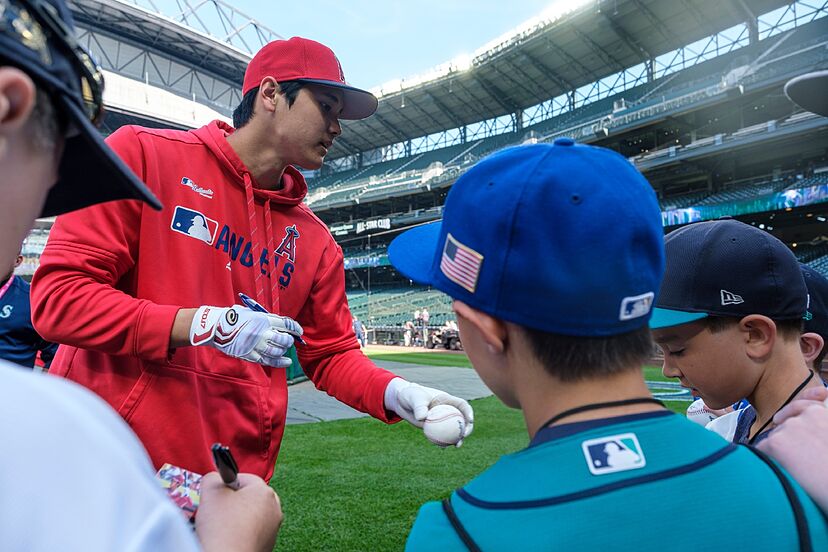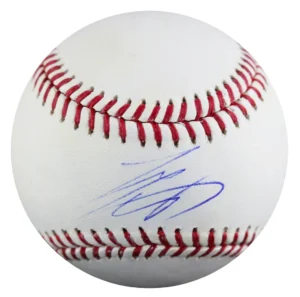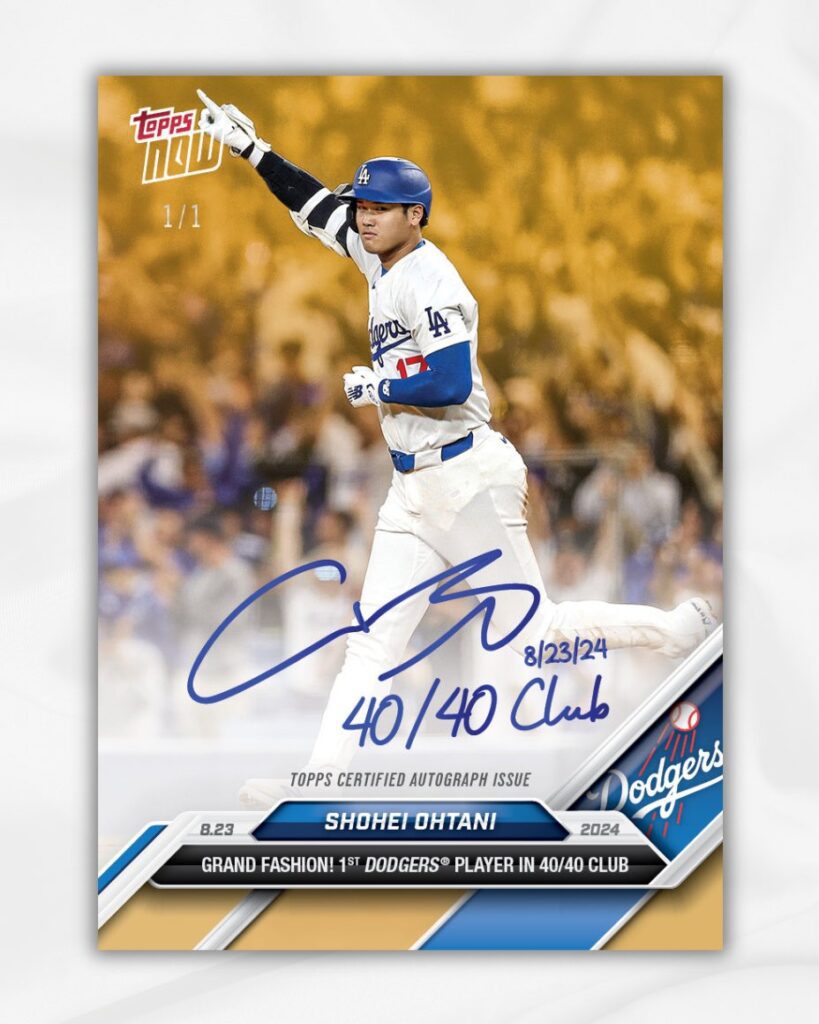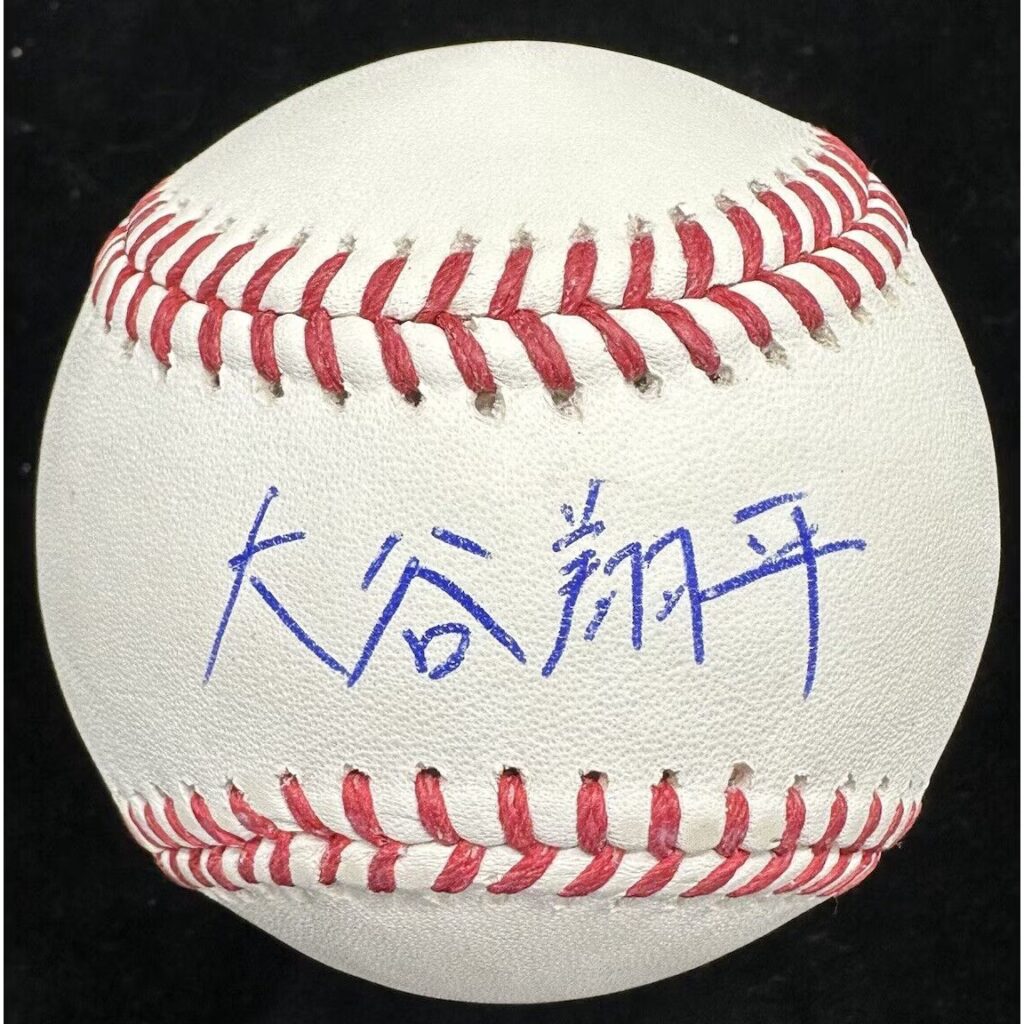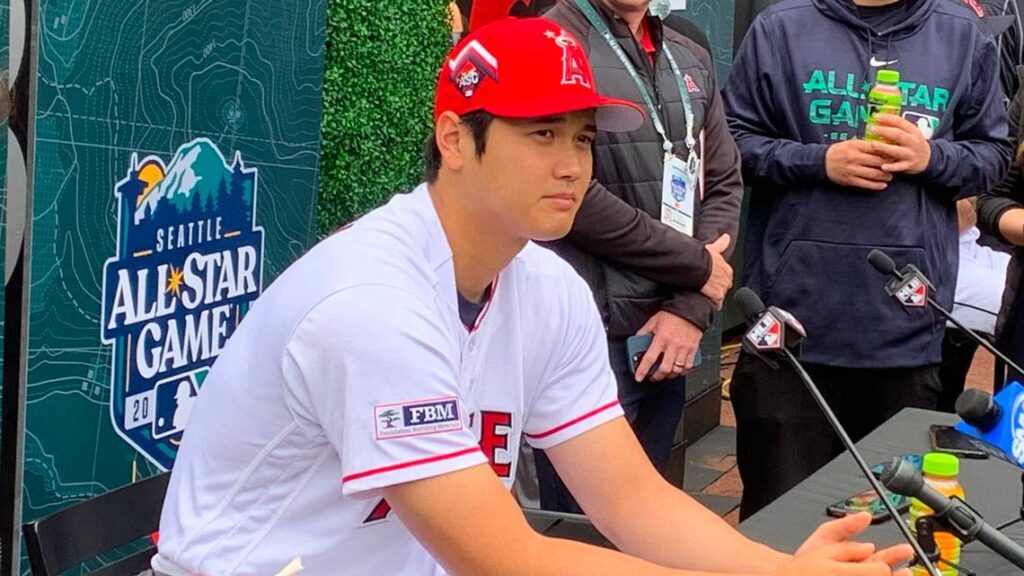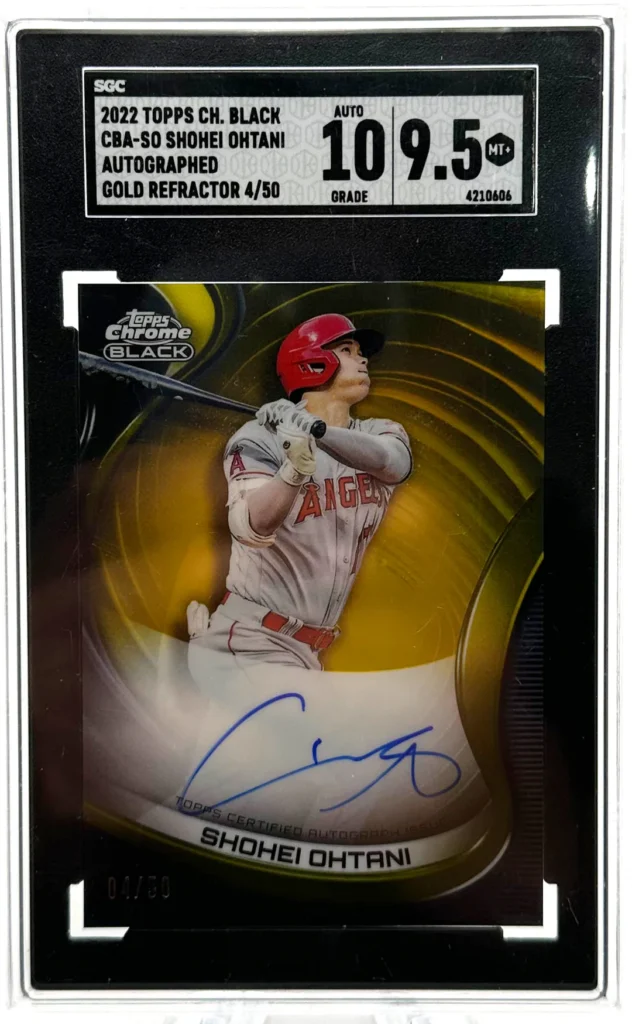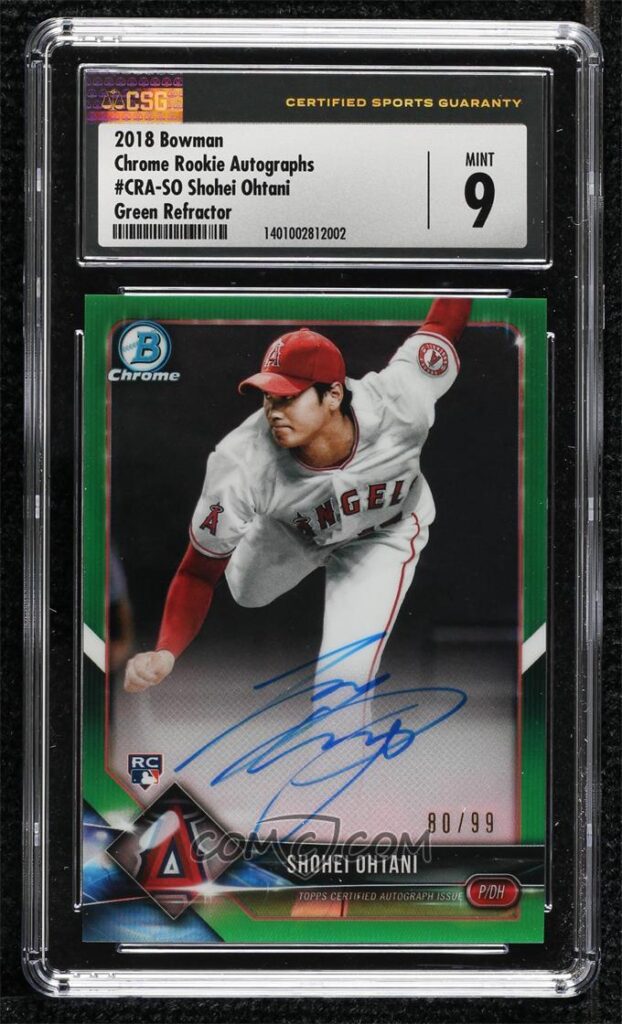Shohei Ohtani’s ascent as a two-way superstar in Major League Baseball has sparked immense interest in his memorabilia, with the new Shohei Ohtani autograph becoming a highly coveted item among collectors. But with recent changes to his signature, there’s a rising concern: Is the new Shohei Ohtani autograph style a collector’s nightmare?
The Meteoric Rise of Shohei Ohtani’s Memorabilia
Shohei Ohtani burst onto the MLB scene with a skill set not seen since Babe Ruth—a pitcher who can hit with power and finesse. This dual-threat capability quickly turned the new Shohei Ohtani autograph and rookie cards into a hot commodity. The hype around his memorabilia has been fueled by his exceptional talent, diligent work ethic, and the groundbreaking nature of his MLB achievements.
Initial Value and Appreciation of Ohtani’s Rookie Cards
When Shohei Ohtani’s rookie cards first hit the market in 2018, they were immediately sought after by collectors and fans. Initial values varied, with base cards selling for modest prices in the tens to hundreds of dollars range, depending on the brand and card condition. However, limited edition cards, especially those featuring autographs or jersey swatches, debuted at higher price points, often reaching the thousands.
As Ohtani began to prove himself in the MLB, the value of his rookie cards escalated significantly. For example, one of the pinnacle items, the 2018 Bowman Chrome Rookie Autographs card, initially valued at a few hundred dollars, saw prices skyrocket into the five-figure range as Ohtani continued to dominate on the mound and at the plate. The scarcity of high-grade versions of these cards and the excitement around his unique talents drove these values up.
Record-Breaking Sales at Auction
The auction scene for Ohtani’s memorabilia has seen several high-profile sales. One notable sale was a 2018 Bowman Chrome Red Refractor signed rookie card, limited to just five copies, which sold for over $180,000. Another key sale featured a 1-of-1 Ohtani rookie card from the 2018 Topps Heritage Real One series, which fetched an impressive six-figure sum.
The peak of Ohtani’s auction success was likely influenced by his 2021 performance, during which he showcased unparalleled excellence as a pitcher and a batter, leading to serious MVP consideration. This season solidified his status in the sports world and thus his memorabilia market.
Other High Ticket Items
Beyond rookie cards, other items like game-used memorabilia have also fetched high prices. Game-used bats, jerseys, and even baseballs from significant games in Ohtani’s career are highly prized. For instance, a jersey worn during his rookie season sold for over $40,000 at auction, and a bat used during a home run game in his MVP season fetched similar amounts.
Understanding the Value of Ohtani’s Autographs
The allure of Shohei Ohtani’s memorabilia, particularly his autographs, lies in the unique blend of rarity, artistic quality, and personal touch each signature embodies. Initially, the new Shohei Ohtani autograph, characterized by its resemblance to two sideways “M”s with a loop, captured the attention of fans and collectors alike. This complex signature style suggested that Ohtani took considerable time and care with each signing, a practice that not only showcased his dedication but also infused his autographs with a distinct personal charm.
Artistic Value of the Autograph
The initial style of the new Shohei Ohtani autograph, which could be likened to a seismograph or a heart rate monitor, added an artistic layer to his signature that went beyond mere athlete memorabilia. The fluid motion and intricate loops reflected a rhythm and precision that mirrored Ohtani’s playing style—dynamic, precise, and impactful. Such artistic signatures are not just seen as autographs; they are often viewed as personal artworks from the athletes themselves, making each new Shohei Ohtani autograph a piece of art in its own right.
Emotional Connection and Fan Appeal
The complexity and care evident in Ohtani’s autograph create a stronger emotional connection with the fans. This connection is crucial, as it elevates the autograph from a simple signature to a cherished keepsake that fans and collectors are more eager to acquire and hold onto. The personal touch in each new Shohei Ohtani autograph resonates deeply, reminding fans of their favorite moments watching him play, whether he’s striking out batters or hitting home runs.
Impact on Market Value
Autographs that show a high degree of personalization and care generally command higher prices in the memorabilia market. The initial intricate style of the new Shohei Ohtani autograph made his signed items highly desirable and often led to premium pricing, especially for limited edition items or those used in significant games. As Ohtani’s fame and achievements in MLB grew, so did the demand for his autographs, propelling their value even higher.
Collectibility and Longevity
Autographs that are distinct and visually appealing, like the early versions of the new Shohei Ohtani autograph, tend to maintain or increase in value over time. Collectors value the uniqueness of each signature and often seek out variations that mark different periods in an athlete’s career. Ohtani’s initial autograph style is likely to be seen as more collectible as he continues to alter his signature, preserving a piece of his early MLB history.
Evolution of Ohtani’s Signature
As Shohei Ohtani’s star rose in Major League Baseball, the demand for his autograph surged, necessitating a more streamlined signature for efficiency. Over time, the new Shohei Ohtani autograph evolved significantly from its original intricate design. This adaptation saw the introduction of a simpler “C” shape flowing into a cursive “Z” or, occasionally, a figure 8. This shift was primarily driven by the need to accommodate the increasing volume of autograph requests he received during public appearances, signings, and fan interactions.
Practical Adjustments for Efficiency
The transition to a more streamlined signature is a common trajectory among athletes who experience a surge in popularity. As Ohtani became a more prominent figure in the sports world, the time available for individual autograph sessions naturally decreased, thereby requiring a quicker signing process. The new Shohei Ohtani autograph, with its “C” and “Z” components, allowed him to sign more items in a shorter period without sacrificing legibility. This practical adjustment ensured that more fans could walk away with a cherished memory, albeit somewhat less personalized than before.
Impact on Signature Uniqueness and Personal Touch
While the evolved new Shohei Ohtani autograph meets the practical needs of signing speed, it also raises concerns about the loss of uniqueness and personal touch that characterized his earlier signatures. The original autograph’s complexity gave it a distinctive aesthetic that could be immediately recognized and highly valued by collectors. The streamlined version, while still identifiable as Ohtani’s, lacks some of the unique flourishes that made his earlier signatures so sought after. This shift could potentially affect the long-term value of new memorabilia bearing his autograph, as items featuring the original signature might be viewed as rarer and more desirable by collectors.
Collector’s Perspective on Value
From a collector’s standpoint, the evolution of the new Shohei Ohtani autograph presents a nuanced investment landscape. While newer autographs are more abundant and accessible, the rarer, more intricate early signatures could command higher premiums in the future. Collectors might find the original style more appealing not only for its aesthetic and rarity but also for its representation of Ohtani’s early career before he achieved global fame.
Market Dynamics
The market for the new Shohei Ohtani autograph reflects a dynamic interplay between supply and demand, authenticity, and the athlete’s ongoing career trajectory. As Ohtani continues to make his mark in MLB, each style phase of his autograph captures a different era of his career, potentially increasing the collectibility of all versions over time. However, the earliest examples remain likely to be the most coveted, preserving a piece of sports history that marks the humble beginnings of a potentially legendary career.
The Latest Signature and Its Controversial Streak
The latest iteration of the new Shohei Ohtani autograph includes the initial “C,” but the following characters can best be described as a series of peaks, almost spelling out “uni” before being crossed through. The most controversial aspect of this new style is the white streak often present in the signature. This streak can severely impact the grading of the new Shohei Ohtani autograph, as uniform ink flow is a critical criterion in autograph grading. Such flaws can lead to lower grades, diminishing the resale value and collector interest.
Comparing with Other Athletes’ Signature Changes
Shohei Ohtani is not the first athlete to alter his signature. Sports legends like Cal Ripken Jr., Ken Griffey Jr., and Manny Ramirez have all modified their autographs over their careers. While changes are often driven by the need for efficiency during signing sessions, they can impact collectability and value. For example, earlier signatures of Ken Griffey Jr. are considered more desirable due to their rarity and the care evident in each new Shohei Ohtani autograph.
Implications for Collectors: Grading and Value of the New Shohei Ohtani Autograph
The evolution of the new Shohei Ohtani autograph, especially with the introduction of the white streak in recent versions, presents a complex scenario for collectors. Understanding how this impacts the grading and subsequent value of these autographs is crucial for anyone looking to invest in or collect Ohtani memorabilia.
Understanding Autograph Grading
Autograph grading is a meticulous process conducted by professional grading services like PSA, Beckett, or JSA. The grading system evaluates the quality and condition of the autograph based on several factors:
- Legibility and Clarity: How clear and legible the signature is.
- Ink Consistency: The uniformity of the ink used in the signature, looking for any smudging or fading.
- Integrity of the Signature: Assessing any breaks or irregularities in the stroke of the autograph.
A high-grade autograph is typically free from smudges, streaks, and breaks, and is uniformly clear and legible. Each of these elements contributes to the overall grade, which significantly affects the market value of the autograph.
Impact of the Shohei Ohtani White Streak
The white streak found in the latest version of the new Shohei Ohtani autograph introduces a significant challenge in terms of grading. This streak typically represents a break in the ink flow, which can occur due to issues with the pen or the manner in which the signature was rendered. Such interruptions can lead to lower grades for the following reasons:
- Consistency Interruption: Grading services view ink consistency as a key determinant of quality. A white streak disrupts this consistency, often leading to a downgrade.
- Visual Appeal: Collectors value the aesthetic of a clean and uninterrupted signature. A white streak can detract from the visual appeal, making the autograph less desirable in the eyes of some collectors.
Long-Term Value and Collectibility
While the presence of a white streak might lower the grading and immediate market value of the new Shohei Ohtani autograph, it also introduces a rarity element that could influence long-term value in several ways:
- Rarity and Uniqueness: If the white streak is a transient issue in Ohtani’s autographing process, autographs featuring it might become rare over time. This rarity could drive up interest among collectors looking for unique variations of his signature.
- Historical Value: As Ohtani continues to cement his status in MLB history, all variations of his autographs, including those considered less desirable now, may gain historical significance and, consequently, value.
Strategic Considerations for Collectors
For collectors, strategically acquiring the new Shohei Ohtani autograph involves weighing the potential risks against long-term rewards. While graded versions without the white streak are likely to be more immediately valuable, those with the streak offer a speculative opportunity, betting on rarity and future demand as Ohtani’s career progresses.
The changes in the new Shohei Ohtani autograph reflect a broader trend among athletes adapting to the demands of fame. While the new style may pose a grading challenge, it also underscores the dynamic nature of sports memorabilia collecting. Whether the new Shohei Ohtani autograph will indeed become a collector’s nightmare or a unique collectible treasure remains to be seen. As with all investments, potential risks accompany the potential rewards, making each piece of memorabilia a snapshot not just of the athlete’s career, but of the evolving landscape of sports history.

